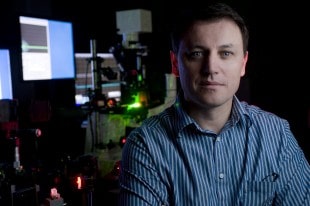
In yet another wrinkle in the rapidly developing area of using nanotechnology to enhance cancer chemotherapy, targeted nanoparticles were used to produce “nanobubbles” inside cancer cells instead of to deliver a chemotherapy drug to the cancer cells. In laboratory tests, the nanobubbles proved to be much more efficient in specifically killing cancer cells while sparing neighboring healthy cells. A hat tip to ScienceDaily for reprinting this Rice University news release with its embedded video “‘Nanobubbles’ plus chemotherapy equals single-cell cancer targeting“:
Using light-harvesting nanoparticles to convert laser energy into “plasmonic nanobubbles,” researchers at Rice University, the University of Texas MD Anderson Cancer Center and Baylor College of Medicine (BCM) are developing new methods to inject drugs and genetic payloads directly into cancer cells. In tests on drug-resistant cancer cells, the researchers found that delivering chemotherapy drugs with nanobubbles was up to 30 times more deadly to cancer cells than traditional drug treatment and required less than one-tenth the clinical dose.
“We are delivering cancer drugs or other genetic cargo at the single-cell level,” said Rice’s Dmitri Lapotko, a biologist and physicist whose plasmonic nanobubble technique is the subject of four new peer-reviewed studies, including one due later this month in the journal Biomaterials and another published April 3 in the journal PLoS ONE [Open Access research article]. “By avoiding healthy cells and delivering the drugs directly inside cancer cells, we can simultaneously increase drug efficacy while lowering the dosage,” he said. …
Rice’s nanobubbles are not nanoparticles; rather, they are short-lived events. The nanobubbles are tiny pockets of air and water vapor that are created when laser light strikes a cluster of nanoparticles and is converted instantly into heat. The bubbles form just below the surface of cancer cells. As the bubbles expand and burst, they briefly open small holes in the surface of the cells and allow cancer drugs to rush inside. The same technique can be used to deliver gene therapies and other therapeutic payloads directly into cells.
This method, which has yet to be tested in animals, will require more research before it might be ready for human testing, said Lapotko, faculty fellow in biochemistry and cell biology and in physics and astronomy at Rice. …
To form the nanobubbles, the researchers must first get the gold nanoclusters inside the cancer cells. The scientists do this by tagging individual gold nanoparticles with an antibody that binds to the surface of the cancer cell. Cells ingest the gold nanoparticles and sequester them together in tiny pockets just below their surfaces.
While a few gold nanoparticles are taken up by healthy cells, the cancer cells take up far more, and the selectivity of the procedure owes to the fact that the minimum threshold of laser energy needed to form a nanobubble in a cancer cell is too low to form a nanobubble in a healthy cell
A given molecular targeting strategy can only achieve a certain ratio of entering cancer cells to entering healthy cells. As the cancer evolves to become more resistant to the drug, that ratio becomes inadequate to kill cancer cells while sparing healthy cells. But because the laser pulse can be precisely controlled, the ratio of gold nanoparticles in cancer cells to the amount in healthy cells is sufficient to ensure that nanobubbles only form in cancer cells, so the drug can only enter the cancer cells. If this approach works as well in an animal model as it does in laboratory cell cultures, it might develop into an effective therapy to kill drug-resistant tumor cells.
—James Lewis, PhD

